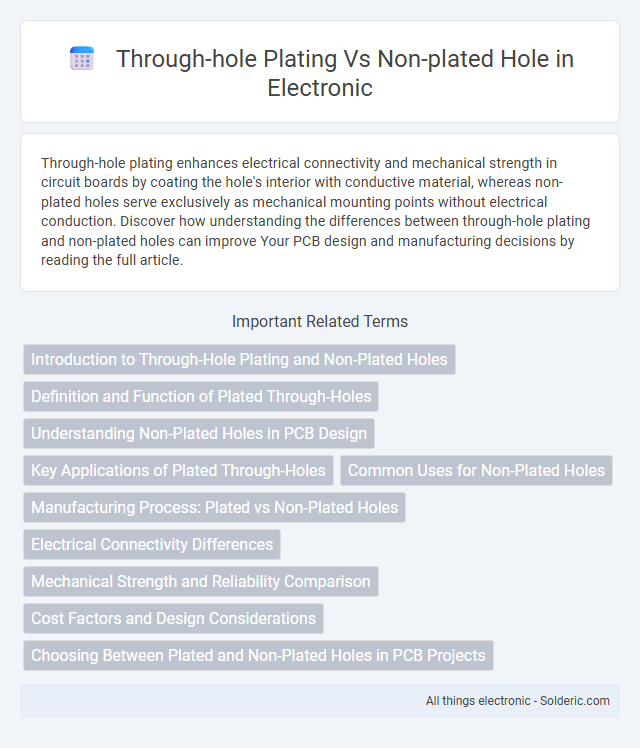Through-hole plating enhances electrical connectivity and mechanical strength in circuit boards by coating the hole's interior with conductive material, whereas non-plated holes serve exclusively as mechanical mounting points without electrical conduction. Discover how understanding the differences between through-hole plating and non-plated holes can improve Your PCB design and manufacturing decisions by reading the full article.
Comparison Table
| Feature | Through-Hole Plating | Non-Plated Hole |
|---|---|---|
| Definition | Holes with conductive plating connecting PCB layers | Holes without conductive plating, used for mounting or alignment |
| Function | Electrical connection between layers | Mechanical support or positioning only |
| Electrical Conductivity | Conductive | Non-conductive |
| Use Case | Component mounting, signal routing | Tooling holes, mechanical fastening |
| Manufacturing Complexity | Higher, requires plating process | Lower, simpler drilling only |
| Cost Impact | Increases PCB cost | Minimal cost addition |
| Reliability | Ensures robust electrical connection | No electrical functionality |
Introduction to Through-Hole Plating and Non-Plated Holes
Through-hole plating involves coating the walls of drilled holes in printed circuit boards (PCBs) with a conductive layer to establish electrical connections between different layers, enhancing signal integrity and mechanical strength. Non-plated holes, by contrast, are uncoated drilled holes that serve purposes such as mounting or alignment without creating electrical pathways. Understanding the distinctions between these hole types is crucial for PCB design decisions related to electrical performance and assembly requirements.
Definition and Function of Plated Through-Holes
Plated through-holes (PTH) are conductive pathways created by electroplating the walls of drilled holes in printed circuit boards (PCBs), enabling electrical connections between different layers. Non-plated holes lack this conductive layer, serving primarily as mechanical mounting points or alignment guides without facilitating electrical connectivity. Understanding the function of plated through-holes is essential for designing your PCB to ensure proper signal transmission and structural integrity.
Understanding Non-Plated Holes in PCB Design
Non-plated holes (NPH) in PCB design serve as mechanical or mounting points without electrical conductivity, contrasting with through-hole plating that creates conductive pathways connecting PCB layers. Understanding non-plated holes is crucial for ensuring proper component placement and structural integrity, as they do not participate in circuit connections but provide stability and alignment. Designers must account for the absence of copper plating to prevent unintended electrical shorts and maintain signal integrity in multi-layer boards.
Key Applications of Plated Through-Holes
Plated through-holes (PTH) are crucial in multilayer printed circuit boards (PCBs) for establishing electrical connections between different layers, commonly used in complex electronics such as computers, smartphones, and aerospace systems. These holes provide mechanical strength and robust conductivity, enabling reliable signal transmission and component mounting in high-density circuits. Non-plated holes are typically used for mounting purposes or alignment, where electrical connectivity is not required, making PTH the preferred choice for critical electrical interconnections in advanced PCB designs.
Common Uses for Non-Plated Holes
Non-plated holes in printed circuit boards (PCBs) are commonly used for mechanical fasteners, alignment purposes, and as tooling holes during manufacturing. These holes provide structural support or precise positioning without requiring electrical connectivity. Their applications often include mounting components, securing the PCB within enclosures, and assisting in automated assembly processes.
Manufacturing Process: Plated vs Non-Plated Holes
Through-hole plating involves depositing a thin layer of metal on the inner walls of drilled holes in printed circuit boards (PCBs) to establish electrical connectivity between different layers. Non-plated holes lack this conductive coating and are typically used as mechanical mounting points or alignment guides without electrical function. The plated through-hole manufacturing process requires additional steps such as electroless copper deposition and electroplating, while non-plated holes undergo simpler drilling and finishing without metallization.
Electrical Connectivity Differences
Through-hole plating provides reliable electrical connectivity by creating a conductive path between different layers of a printed circuit board (PCB), enabling signal and power transmission through vias. Non-plated holes lack this conductive coating, resulting in no electrical connection between layers and are primarily used for mechanical mounting or alignment. The choice between through-hole plating and non-plated holes directly impacts circuit continuity, impedance control, and overall PCB functionality.
Mechanical Strength and Reliability Comparison
Through-hole plating significantly enhances mechanical strength by reinforcing hole walls with a conductive metal layer, making your PCB more resistant to stress and vibration. Non-plated holes lack this reinforcement, leading to reduced structural integrity and higher risk of delamination or damage under mechanical strain. Reliable electrical connections and long-lasting durability in through-hole plated PCBs make them essential for high-performance, heavy-duty applications.
Cost Factors and Design Considerations
Through-hole plating increases PCB manufacturing costs due to additional plating processes and materials, while non-plated holes reduce expenses by eliminating these steps. Design considerations for through-hole plating include enhanced electrical connectivity and mechanical strength, essential for vias and component leads. Non-plated holes are primarily used for mounting or alignment, where electrical conduction is not required, offering simpler and more cost-effective designs.
Choosing Between Plated and Non-Plated Holes in PCB Projects
Choosing between plated through-hole (PTH) and non-plated holes (NPTH) in PCB projects depends on electrical connectivity and mechanical requirements. PTH provides conductive pathways essential for component mounting and signal transmission, making them ideal for multi-layer boards and complex circuits. Your decision should consider whether the hole needs electrical continuity, as NPTH is typically used for mounting or alignment without electrical connection.
Through-hole plating vs non-plated hole Infographic

 solderic.com
solderic.com